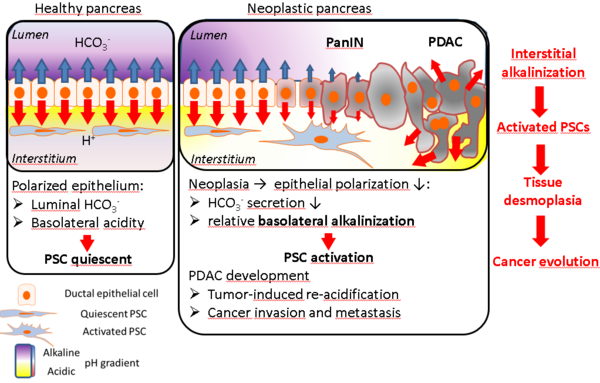Pancreatic ductal adenocarcinoma (PDAC) is the fourth most common cause of cancer-related death. The disease is almost always fatal and its incidence is growing at a time when many other cancers are in decline. The knowledge of the molecular mechanisms that give rise to PDAC are far from clear and have not yet delivered targeted therapies.
PDAC is inherently linked to the unique physiology and microenvironment of the exocrine pancreas where dynamic changes in extracellular and intracellular pH (pHe/pHi) arise. Specifically, the exocrine pancreas secretes substantial amounts of bicarbonate into the ductal lumen (figure 1); when stimulated by post-prandial hormones, luminal [HCO3-] reaches 150 mM. Secretion of base across the apical membrane is coupled to the extrusion of an equal amount of acid across the basolateral membrane, thereby acidifying the pancreatic interstitium. Thus, pancreatic epithelium and stromal cells are exposed to a milieu of spatially and temporally varying pHe, with episodes of substantial acidity. Epithelial cells of the pancreatic ducts are therefore challenged to maintain pHi constancy despite the vast acid-base fluxes.

Fig. 1: Normal pancreatic physiology generates an acidic interstitium. This may facilitate progression towards invasive PDAC since tumour precursor cells have been preconditioned in a potentially hostile acidic environment. (modified from Pedersen SF et al., 2017 Bioessays 39, 6, 1600253).
An acidic microenvironment drives cancer progression by selecting aggressive cellular phenotypes e.g. with higher metastatic potential. The underlying mechanisms remain unclear. Acid selection of specific cancer phenotypes may trigger disease progression. Current research efforts to improve PDAC treatment and diagnosis do not take into account the unique pancreatic pH landscape, despite the consensus that acidosis is a central feature of cancer.
Our previous IonTraC project has clearly demonstrated that the hallmarks of PDAC are driven by altered regulation of ion transport proteins, including acid-base transporters and pH-sensitive ion channels. Our work shows that these "workhorses" of normal epithelial cells are misused in cancer (see www.medizin.uni-muenster.de/iontrac/news/ for IonTraC publication list).
pHioniC will therefore test the hypothesis that the unique pancreatic pH landscape favours and/or enables driver mutations of transport proteins to influence PDAC progression. A detailed description of our hypothesis can be found in: Pedersen SF, Novak I, Alves F, Schwab A, Pardo LA 2017. Alternating pH landscapes shape epithelial cancer initiation and progression. Focus on pancreatic cancer. Bioessays 39, 6, 1600253. Moreover, we refer to a recent review by one of our partners on the basic principles of cellular pH regulation and its importance in cancer.